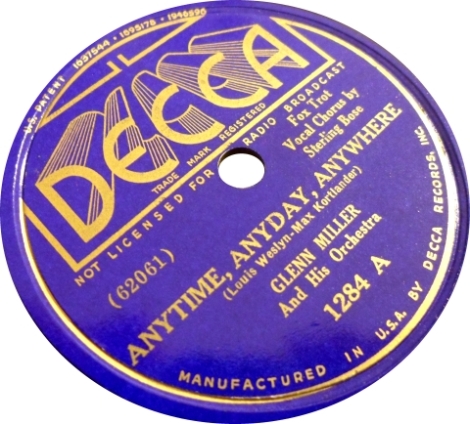Decca Studios, New York – March 22, 1937
Charlie Spivak, Mannie Klein (tp), Stirling Bose (tp,vcl); Glenn Miller (tb,arr), Jesse Ralph, Harry Rogers (tb); Hal McIntyre (cl,as,arr), George Siravo (as,arr), Jerry Jerome, Carl Biesecker (ts); Howard Smith (p); Dick McDonough (g); Ted Kotsoftis (b); George T. Simon (d); Doris Kerr, The Tune Twisters (vcl). Glenn is the arranger on all titles except the last, which was arranged by Hal McIntyre.
62058-A Peg O’ My Heart Decca 1342
62059-A Wistful and Blue (dk vcl) Decca 1284
62060-A How Am I To Know ? (dk vcl) Decca 1239
62061-A Anytime, Anyday, Anywhere (sb, tt vcl) Decca 1284
62062-A Moonlight Bay (band vcl) Decca 1239
62063-A I’m Sittin’ on Top of the World Decca 1342

It’s almost two years since the Columbia session and this session marks the first that Glenn led with his own performing band, with the personnel bolstered by several friends. Glenn had freelanced as a studio musician after leaving the Ray Noble band in mid-1936 and was seriously looking to start his own group by the end of the year. By February 1937, the band was rehearsing around New York and Glenn’s reps landed a one-shot date at Decca.
Trumpeters Spivak, Klein and Bose, pianist Howard Smith (borrowed from Tommy Dorsey) and guitarist Mc Donough were the ringers; the rest of the guys were Glenn’s newcomers. George Simon, editor at Metronome Magazine and close friend of Glenn’s, had helped in finding musicians and was tapped for the drum chair, since Glenn was having trouble locating a good drummer that he could afford. Singer Doris Kerr was related to an NBC radio executive and then performing on sustaining broadcasts. She sings pleasantly in a similar style to Glenn’s other early female vocalists, Kathleen Lane and Gail Reese.
Simon later recounted the incredible pressure Glenn put on the musicians to produce six, rather than the usual four sides, in the three-hour time frame imposed by the musicians’ union. Most record dates at that time were expected to complete four finished masters in the time allotted, but there were no constraints on completing more if you could. Well, Glenn made sure they could!
That pressure is evident in the rather tense atmosphere on the records. As before, the band does not sound terribly relaxed and the rhythm section pushes hard throughout. Refusing to put himself in competition with Tommy Dorsey, Glenn didn’t play on the session and no other trombone solos are to be heard.
It was often the case with new bands on one-shot record dates that the songs chosen were standards, so the record label could space out the releases if they liked, without having to worry about new tunes becoming dated. The newest song performed here is 1929’s HOW AM I TO KNOW and the oldest was almost moldy, namely MOONLIGHT BAY, published way back in 1912. PEG O’MY HEART was just a year younger.
Though the songs were vintage, they were well-chosen by Glenn, as none would become Swing Era warhorses. Glenn’s arrangements were fresh and filed with interesting ideas and voicings. It’s surprising to hear Biesecker’s tenor sax used several times as a lead instrument in the reed section. The famous “Miller Sound” of clarinet-over-reeds had not yet been thought of.
Soloists Biesecker and McIntyre come off best with imaginative contributions. Biesecker would remain with Glenn for the rest of the year and McIntyre stayed until 1941, but was rarely featured as he was here.
After the first three numbers, done at a rather plodding mid-tempo, the band noticeably loosens up a bit for the remainder of the date. ANYTIME, ANYDAY, ANYWHERE is the gem of the session, with an endearingly mush-mouthed vocal and solo by trumpeter Stirling Bose (who had played and sung with Glenn in the Noble band). Also Noble band alumni were the Tune Twisters, who were earlier known as “The Freshmen.” Jack Lathrop, one of the Freshmen-Twisters, later joined the Miller band as guitarist and occasional vocalist.
MOONLIGHT BAY is perhaps the most recognizably Miller-style chart, with little clarinet fills throughout that are reminiscent of his hot charts for the Dorsey Brothers and Noble. These fussy little touches, though distinctive, would soon disappear from Glenn’s arrangements as they became more forward-looking in the months to come.
For years, these records were hard to come by. Now, of course, they are included on numerous CDs and are all over the Internet. Back in 1967, British Decca’s budget LP label Ace of Hearts reissued them on microgroove for the first time, as THE SWING-HAPPY YEARS. 
Six sides by the Jan Savitt band completed the LP, several with Miller connections, like MOONLIGHT SERENADE and TUXEDO JUNCTION. For this young Miller collector, Manhattan’s King Karol or Doubleday’s were the only places to find such esoteric imports.
Yours truly was thrilled to hear these unfamiliar records, but not too happy with writer Michael Brooks’ liner notes. This was my first acquaintance with his snarky style and his dislike of the Miller band was way apparent here. After grudgingly stating that these Deccas were not so bad, he opined, “There is also a looseness in the playing that Miller would never have tolerated a few years later, when he led a bunch of bland, soporific Trilbys who obeyed their leader’s written instructions to the note. In 1937, Miller hadn’t quite grasped that an all-star combination tends to obscure the leading light. He didn’t make the same mistake twice.”
Wow. “Bland, soporific Trilbys.” I had to look up two of the three words in that statement. And I remain wary of Michael Brooks to this day.








